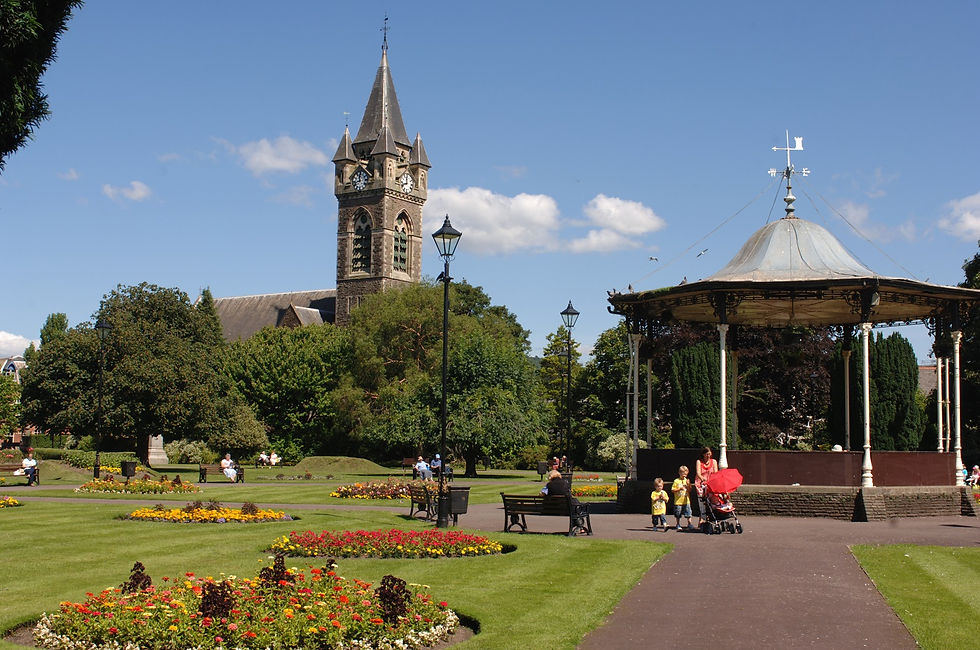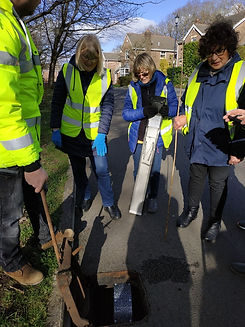
Urban Habitats
Gardens, hard engineering, parks, green infrastructure
The State of Nature in Urban Habitats in Neath Port Talbot
There are significant challenges for nature in the urban landscape and species are threatened by, amongst other things, loss of nesting sites, lack of connectivity and inappropriate habitat management (e.g. mowing through flowering season). Although most urban areas in NPT contain wildlife habitat, in many areas this is not by design and there is a need for more areas to be specifically managed and maintained for nature in urban areas. Many species in urban habitats have decreased significantly in NPT in recent decades e.g. swifts and hedgehogs.
Urban habitats support 13 priority species and, accordingly, their diversity has been assessed as fair. Connectivity between urban landscapes is good, but it is difficult to frame this specifically in terms of good habitat connectivity. For example, the level of connectivity between gardens for species such as Hedgehog and Slow Worm is unknown. Most of the urban habitats in NPT are not managed with biodiversity in mind and there are regular losses of habitat as a result of human activity e.g. loss of nest sites for swifts as repairs take place on buildings, therefore their condition is poor. Taking all of this into account, the state of nature and resilience of Urban Habitats in NPT has been assessed as fair.
OVERVIEW
Urban Habitats, such as buildings, parks and gardens, support 5% of NPT's Priority Species although none of them are specific to this broad habitat category. Nevertheless, since Urban Habitats make up more than 15% of the land surface of NPT, there is a significant potential here to enhance biodiversity through the creation and management of nature-friendly networks of gardens, parkland and buildings. They are particularly important habitats for birds that utilise the eaves of houses for nesting places, and bat species that make their homes in roof spaces and dilapidated buildings. Other important species such as Hedgehog and Slow Worm are commonly associated with urban gardens. Urban Habitats can also play a significant connectivity role, e.g. parks can provide ‘stepping stones’ of habitat in amongst urban features, while grassy commons, verges and hedges may be important for connecting these habitats throughout urban areas. Bee-friendly gardens can play a crucial role in the conservation of pollinators.
The Hedgehog is an iconic garden species that has been recorded in most urban settlements in NPT and a few gardens may also provide opportunities for Badger and Otter. Margam Park is one of the best bat sites in the UK, providing roosting sites and foraging habitat for 14 of the 18 UK bat species. Breeding populations of Herring Gull, House Sparrow, and House Martin can be found on buildings in suitable places, while Swift have undergone significant decreases in numbers over the last 50 years. Toads breed in Cwm-Clydach pond before dispersing to neighbouring gardens and fields for the rest of the year. Along the coastal conurbations of Sandfields and Aberavon, rare bumblebees including the Brown Banded Carder and Shrill Carder Bees can be found foraging on patches of wildflowers.
As a result of the COVID Lockdowns in 2020, the NPT LNP noticed an increase in public interest in nature conservation as people became more aware of the nature in their local areas. This is an important opportunity to encourage appropriate action and raise awareness of ways in which local people can assist nature locally without causing inadvertent harm.


Actions for the recovery of
Urban habitats in NPT
Responsibility for these actions lie with all of us and as such, we have not sought to assign actions to particular organisations or groups. Instead, it is our hope that this document will provide the guidance and inspiration for anybody, or any group or organisation, to undertake the actions that are within their capability to deliver. The Secretariat of NPT LNP (NPT Council) are providing a facilitation role to support, collate and monitor work towards these actions. If you would like to discuss your potential involvement in delivery of these actions, please get in touch with biodiversity@npt.gov.uk.


© Vaughn Matthews

© Vaughn Matthews
HEDGEHOG
The Hedgehog is well recorded in most of the urban areas of NPT, although many of these records are from road deaths. The perils of crossing roads, along with other pressures such as barriers between gardens and the use of toxic slug pellets are contributing to the decline of this iconic species. A trend for 'tidy', low maintenance gardens is leading to additional habitat loss for the 'gardeners' friend'.
SWIFT
This summer visitor breeds in mainly urban areas in NPT however numbers recorded as confirmed breeders have declined in recent years. This decline is thought to be due in part to a loss of nesting opportunities as buildings are renovated to modern standards. The provision of nest boxes or integral swift bricks in suitable buildings may help to increase available nesting sites.
COMMON TOAD
The Common Toad is another species susceptible to road deaths in NPT, when in spring, they migrate across urban areas in their hundreds to their breeding ponds. The case study below provides an account of how members of the LNP are working to ameliorate this. Although Toads are likely to be well distributed in NPT, they are under- recorded.
Urban Projects in NPT
CASE STUDY
BRYNCOCH TOAD PATROL
Although associated with water, toads and other amphibians actually spend most of the year on land. When they are not at their breeding ponds, they disperse into the surrounding countryside. However, each spring, toads return to their spawning ponds in large numbers. They favour deeper and bigger ponds than frogs and are quite loyal to particular sites. This means they often have to travel long distances, often through urban areas where they have to cross roads on their journey.
Every year since 2006, during the toad migration season (around March), members of the Bryncoch Environment Group (BEG) are out each night to rescue toads on local roads as they travel to their breeding ponds. In the first year of this operation 970 toads were rescued while 799 were rescued in 2019. Over the last 13 years thousands of amphibians have been saved by BEG members assisted by a large number of volunteers who are concerned for the decline in toad and frog numbers in recent decades.
One of the main problems that the BEG have to overcome is the rescue of large number of toads that fall into drainage gully pots on the sides of roads, from which the toads are unable to escape. As a result, during their “toad patrol” the volunteers spend a lot of their time lifting the gully pots and rescuing toads with fishing nets. The rescued toads are then put into buckets and transported directly to their spawning pond. To reduce the time spent checking every gully pot, the group applied to the LNP for funding to purchase ‘toad ladders’, specially designed structures which sit in the gully pots and allow toads to escape after falling in. The LNP was able to purchase ten ladders for the group which were installed in gully pots around Bryncoch.

